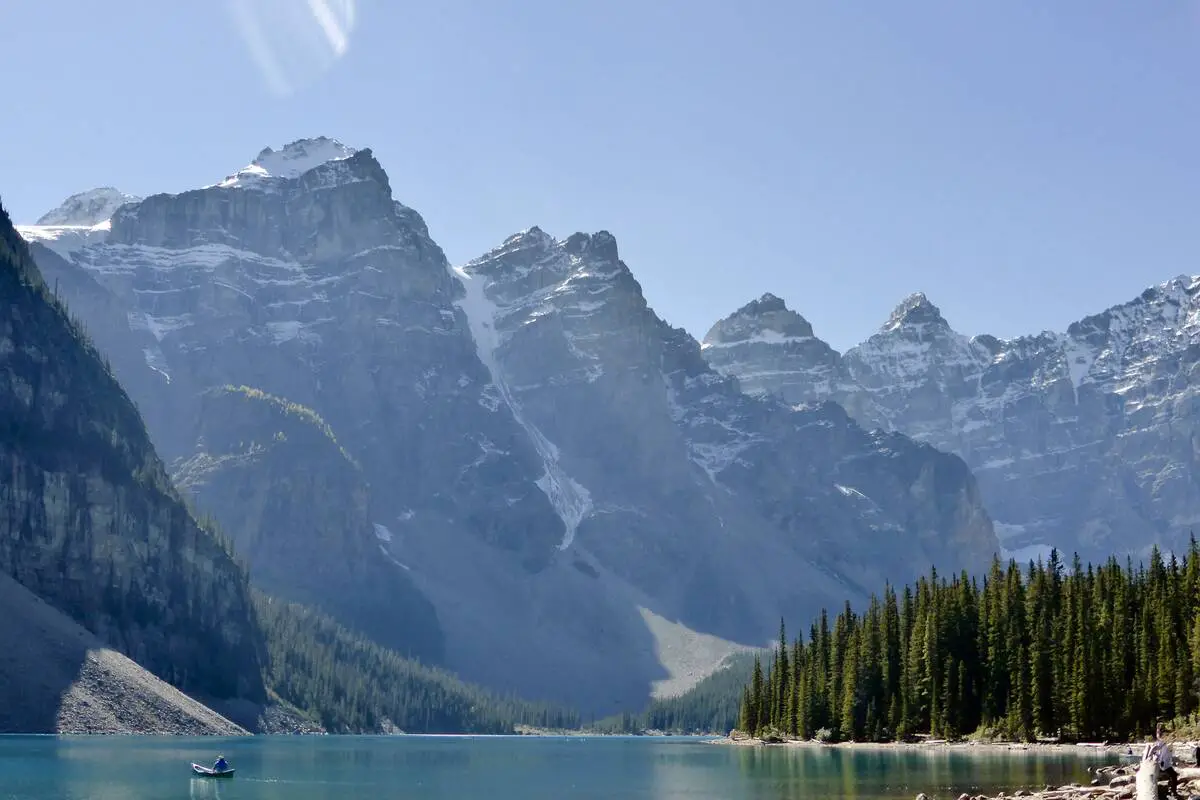While most tourists visit Banff National Park for its jaw-dropping scenery, it’s also an excellent location for a plethora of water activities. In this blog post, I listed eight water activities for you to try during your stay in the park.
I get it; when it’s unbearably hot in Banff, you want to splash around to stay cool. Even though the surroundings beg to be explored.
Besides the many ways you can enjoy water activities in the park, you’ll always be treated to breathtaking scenery. And that’s a good thing. No, it’s an unforgettable experience!
So let me tell you this: Check out this post, make up your mind about what water activity you’re going to do and then go do it!
Canoeing / Kayaking / SUP
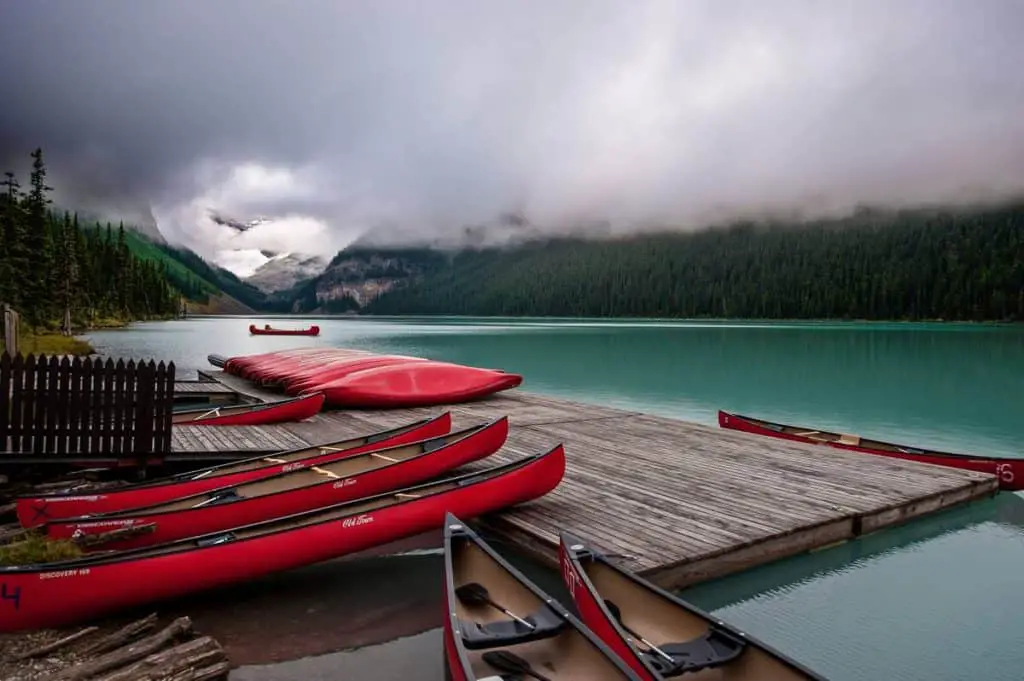
Canoeing, kayaking and stand-up paddleboarding (SUP) are popular water sports in Banff National Park. You can rent a canoe, kayak or SUP from various rental shops, including the Banff Canoe Club, Rad Aventures and the Fairmont Lake Louise Boathouse. You can also rent a SUP at Wilderness Equipment Rentals in Canmore.
Canoeing, kayaking and SUPing are great ways to explore the stunning lakes of Banff, including Lake Louise, Moraine Lake, and Bow Lake. You can enjoy the beautiful scenery and wildlife while paddling on these lakes’ calm waters. Canoeing, in particular, is a great family activity.
If you’re an experienced paddler, you can take three main routes in the park. Their difficulty is intermediate in all three cases:
- Lake Louise to Castle Junction / 22 km/ 3 – 4 hours
- Castle Junction to Banff / 32 km/ 5 – 6 hours
- Bow Falls to Canmore / 23 km/ 4-5 hours
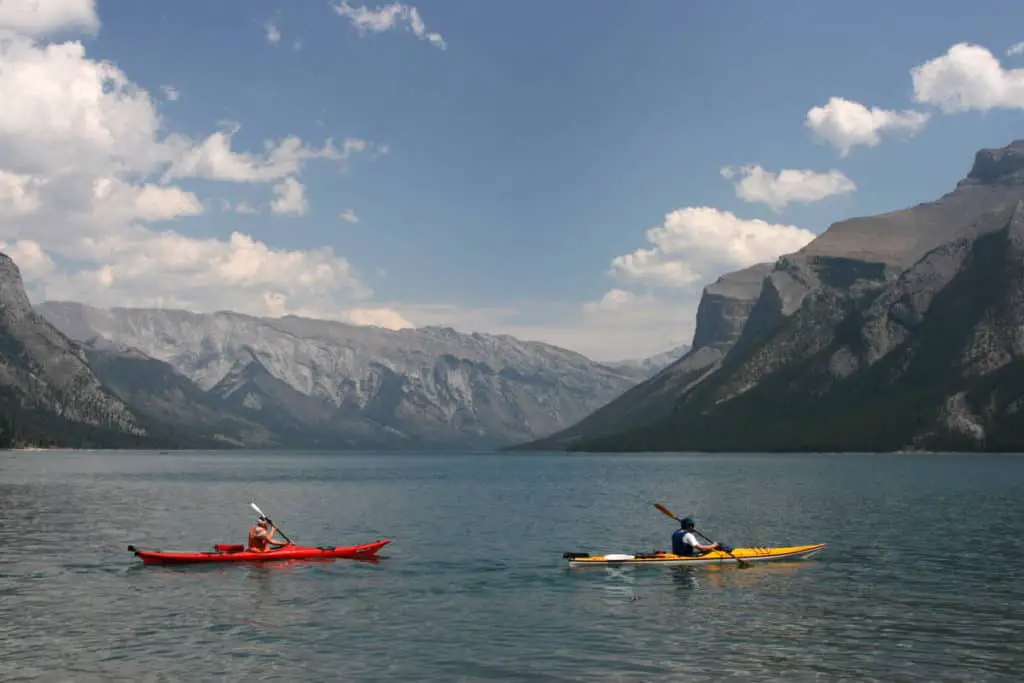
While kayaking is similar to canoeing, stand-up paddleboarding is a relatively new water activity in Banff National Park.
Using a SUP is a great way to explore the lakes and rivers of Banff, including the Bow River and Vermilion Lakes. You can enjoy the beautiful scenery and wildlife while standing on the board and paddling on the calm waters of these lakes and rivers.
But don’t take it lightly. SUPing looks deceptively easy. You might need some practice before you can cover some distance without problems. It’s a matter of keeping your balance on an unstable surface.
Where to Do:
The table below lists the type of watercraft available for rent, the locations, and the period these waterbodies are accessible for these activities.
| NAME | Canoe rental | Kayak rental | SUP rental | Motor Boat rental | When |
|---|---|---|---|---|---|
| Bow River | ✓ | ✓ | ✓ | ✗ | June – October |
| Vermilion Lakes | ✓ | ✓ | ✓ | ✗ | June – October |
| Lake Minnewanka | ✓ | ✓ | ✗ | ✓ | June – October |
| Johnson Lake | ✗ | ✗ | ✗ | ✗ | June – October |
| Lake Louise | ✓ | ✗ | ✗ | ✗ | Mid-June – October |
| Moraine Lake | ✓ | ✗ | ✗ | ✗ | Mid-June – Mid-September |
| Herbert Lake | ✗ | ✗ | ✗ | ✗ | June – October |
| Bow Lake | ✗ | ✗ | ✗ | ✗ | Mid-June – October |
| Waterfowl Lakes | ✗ | ✗ | ✗ | ✗ | Mid-June – October |
Prices*
Vermilion Lakes
- Canoe: CAD 55 for first hour / CAD 30 per additional hour
- Kayak: CAD 55 for first hour / CAD 30 per additional hour
- SUP: CAD 30 per hour / CAD 90 for the day
Bow River
- Canoe: CAD 55 for first hour / CAD 30 per additional hour
- Kayak: CAD 55 for first hour / CAD 30 per additional hour
- SUP: CAD 30 per hour / CAD 90 for the day
Lake Minnewanka
- Canoe: CAD 85 for the first hour / CAD 42,50 per additional hour
- Kayak CAD 45 first hour / CAD 22,50 per additional hour
Lake Louise
Canoe
- In-House guest: CAD 95 for one hour / CAD 85 for 30 minutes
- Day visitor: CAD 135 for one hour / CAD 125 for 30 minutes
Moraine Lake
- Canoe: CAD 115 per hour
* Prices exclude 5% GST.
Rent Gear to Take to the Water
Below you’ll find information about two locations where you can rent kayaks or stand-up paddleboards (SUPs) for trips to lakes or rivers without rental facilities.
Radventures
Address: 433 Banff Ave, Banff
Phone: +1 403 – 493 9556
E-mail: yourpals@radventurescanada.com
Website: radventurescanada.com
Wilderness Equipment Rentals
Address: 129 Bow Meadows Crescent, Canmore
Phone: +1 403 – 609 1610
E-mail: info@wildernessrentals.ca
Website: wildernessrentals.ca
Rafting
If you’re looking for an adrenaline rush on the water, rafting is the way in the Rockies. You can enjoy a thrilling ride on the Bow River, the Kicking Horse River and the Kananaskis River rapids.
You can choose from rafting tours, including half-day, full-day, and multi-day tours. Rafting is a great way to experience the adrenaline rush of white water rafting while enjoying the beautiful scenery of Banff National Park.
If you want to try rafting down the rapids, you’ll need to leave the park as there is no wild river rafting in the park.
You can do one rafting tour inside the park, but that’s a so-called float tour. It’s organized by Rocky Mountain Raft Tours and is ideally suited to calmly take in the scenery and beautiful vistas. It’s conveniently located behind the Banff Springs Hotel near the town of Banff.
Want to know more about rafting? Read my guide on rafting in the Rockies.
Where to Do:
- Bow River (near Seebe)
- Kicking Horse River (British Columbia)
- Kananaskis River (Alberta)
Fishing
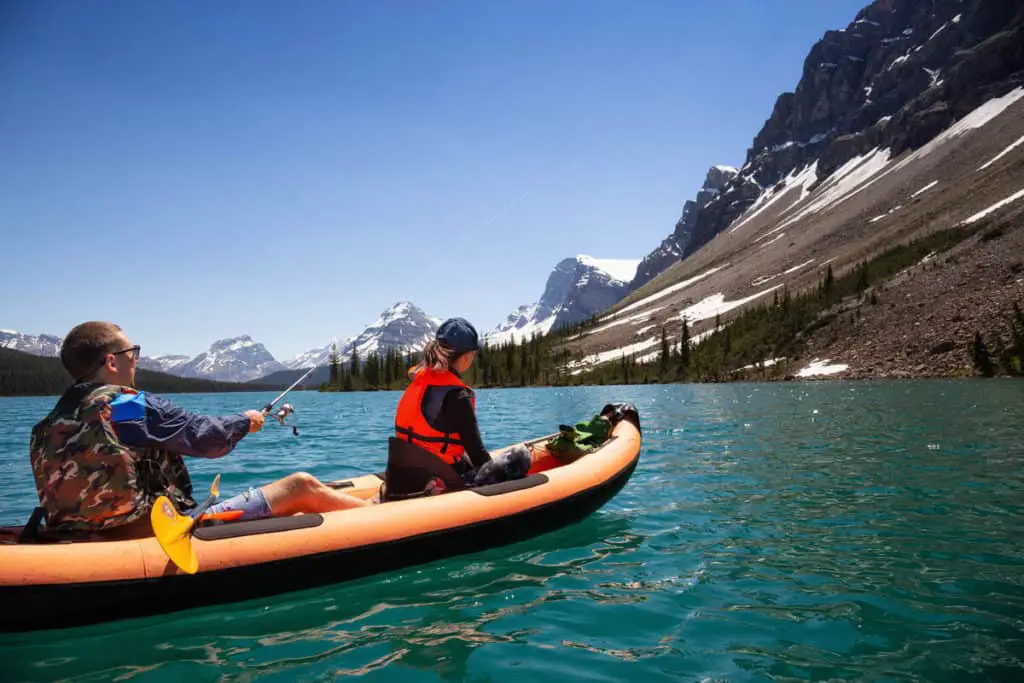
You can enjoy fishing in the lakes and rivers of Banff, including the Bow River and Lake Minnewanka, where you can catch various fish, including trout, pike, and whitefish.
However, it is important to note that you require a license and that the possibilities for fishing in Banff National Park vary depending on the location and species of fish.
The park also has several closed waters like Helen Creek, Lake Agnes and Spray River above the reservoir of Spray Lakes.
Where to Do:
- Lake Minnewanka
- Bow River
- Peyto Lake
- Hector Lake
Where to Rent Gear:
BANFF
Snowtrip Bactrax
Address: 225 Bear Street
Phone: +1 403 – 762 8177
Home Hardware
Address: 223 Bear Street
Phone: +1 403 – 762 2080
LAKE LOUISE
Wilson Mountain Sports
Address: Building A Samson Mall, 101 Lake Louise Drive
Phone: +1 403 – 522 3636
Want to know more about fishing in Banff? Read my guide about fishing in Banff National Park.
Swimming
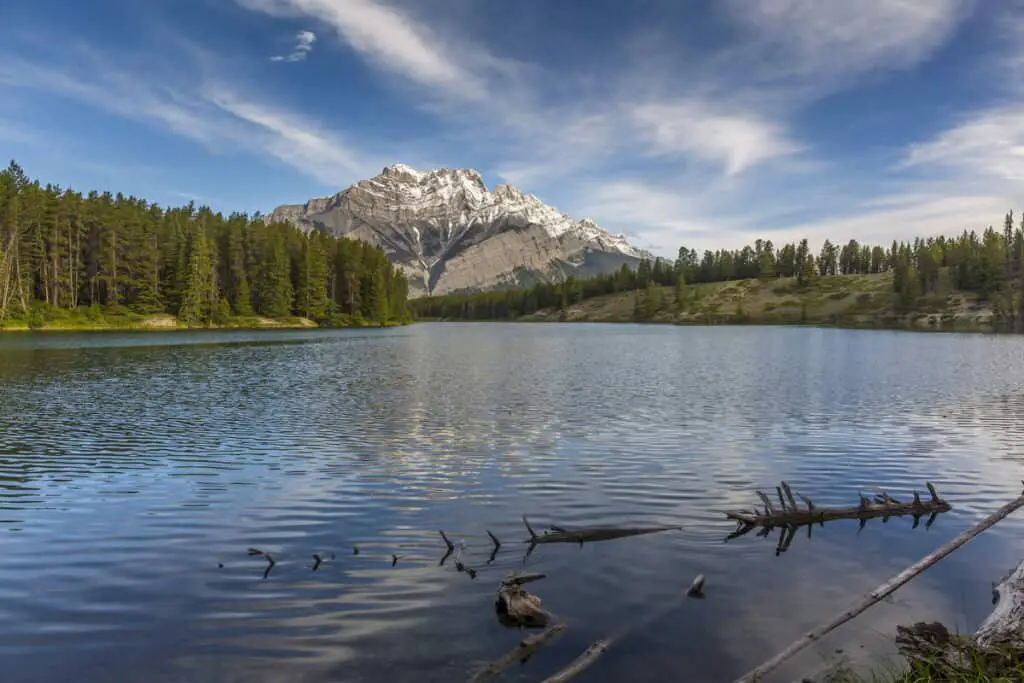
While you can swim in the park’s lakes, you wouldn’t want to because rivers and (most) lakes are glacially fed. As a result, the water is extremely cold (around 5 or 6 degrees Celcius or 41 or 43 Fahrenheit), which causes a high risk of hypothermia if you stay in the water too long.
Luckily, there are three places in Banff National Park where you actually CAN swim without a significant risk of hypothermia.
These are Cascade Ponds and Johnson Lake near the town of Banff and Herbert Lake near Lake Louise.
Where to Do:
- Johnson Lake (see picture above)
- Cascade Ponds
- Herbert Lake
Want to know more? I wrote a comprehensive post about swimming in the park.
Scuba Diving
Scuba diving is a special water activity in Banff National Park. It’s limited to Lake Minnewanka and Two Jack Lake. Both lakes are known for their clear waters and underwater rock formations.
You can see a variety of fish, including trout and whitefish. Lake Minnewanka is, without a doubt, the most interesting of the two, as you can dive into the submerged resort town of Minnewanka Landing.
Where to do:
- Lake Minnewanka
- Two Jack Lake
Where to Rent Gear:
Unfortunately, you can’t rent diving gear in Banff. The closest rental shops are in Calgary.
The Dive Shop
Address: 4652 Macleod Trail South, Calgary
Phone: +1 403- 243 4616
E-mail: scuba@diveshopscuba.com
Website: diveshopscuba.com
Calgary Scuba
Address: 246 Stewart Green SW Suite 1954, Calgary
Phone: +1 403 – 228 5756
E-mail: info@calgaryscuba.com
Website: calgaryscuba.com
Want to know more? Read my guide about Scuba Diving in Banff National Park.
Hot Springs
While not technically a water activity, soaking in the hot springs is a popular way to relax and enjoy the natural beauty of Banff National Park. The Banff Upper Hot Springs and the Radium Hot Springs are famous hot springs in the area.
You can enjoy the warm waters and stunning scenery surrounded by mountains and forests. It is important to note that the hot springs may be crowded during peak tourist season, so it is best to plan ahead.
Want to know more about this topic? Read the comprehensive post about hot springs in the Rockies.
Motorized Boating
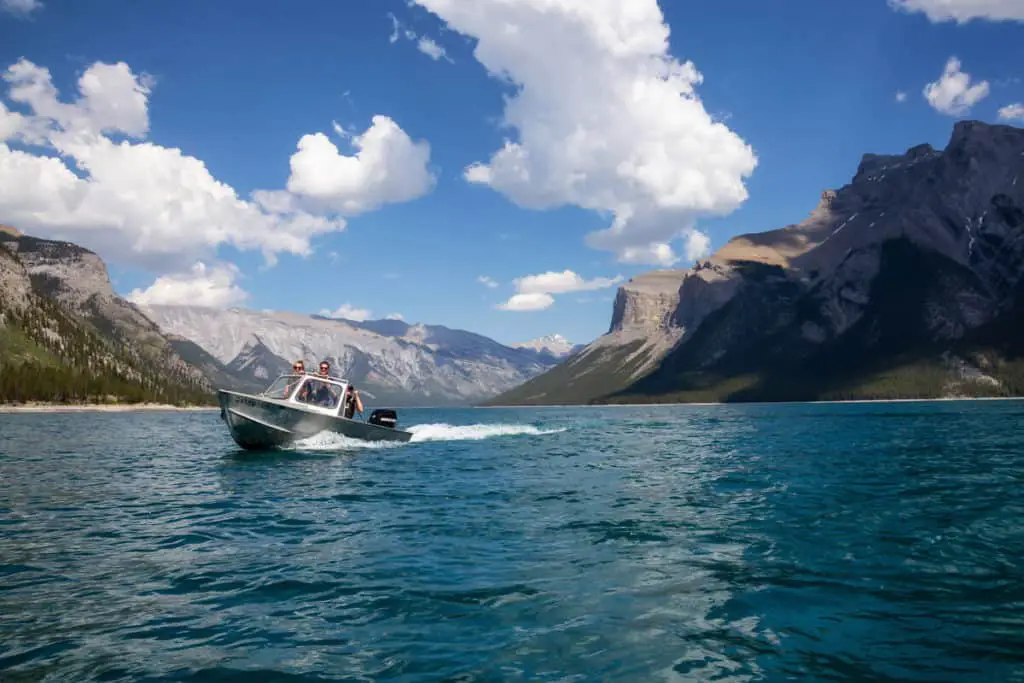
Motorized boating is a pretty popular summer activity in Banff National Park. However, the only lake in the park where it’s allowed is Lake Minnewanka, just a short drive from the town of Banff.
Lake Minnewanka is the largest lake in the park. You can take several guided boat tours of the lake, which provides a unique perspective on the park’s natural beauty.
You can also rent a boat or bring your own.
In case you want to bring your own: there is a boat and trailer parking space and an unloading ramp. The lake doesn’t have any public boat docks.
Renting a Motor Boat in Banff
Renting a motor boat at Lake Minnewanka costs CAD 155 per hour. Any additional hours cost CAD 77.50.
Tips for Water Activities in Banff National Park
Here are nine general tips regarding water activities in Banff National Park:
- All canoe rental operators provide life jackets.
- Make sure you take sunscreen with you. On scorching hot days, you can quickly burn on the water, primarily because the sun reflects off the water.
- Take sunglasses against the sun (it reflects off the water)
- The weather in the Rockies can change rapidly, especially in the mountains and around large bodies of water. Make sure you pack some warm clothing. In case you’re canoeing or kayaking, dress in layers to stay warm.
- Take water with you. Rowing or SUPing can be pretty intense. On a hot summer day, you can get dehydrated quite easily.
- Wear a life jacket or personal flotation device (PFD) if possible/suitable.
- Don’t dive or jump into unfamiliar waters without checking for hazards like rocks or shallow areas.
- If you’re boating, always carry safety equipment, such as a whistle, a distress signal, and a first aid kit.
- Never swim alone or without a designated spotter or lifeguard nearby. It’s always safer to swim with a buddy or group.
Rules and Regulations You Need to Know
Because Banff is a national park, rules and regulations are in place to protect the park’s ecosystem.
To prevent the spread of aquatic invasive species, you must comply with the so-called clean, drain, and dry requirements before you enter a river, lake or stream in the park.
This applies to both motorized and non-motorized watercraft.
The clean, drain, and dry requirements are as follows:
- Clean: Your boat and other water-related equipment should be cleaned of any muck, sand, plant, and animal contaminants.
- Drain: Before leaving the waterbody, empty any buckets, compartments, coolers, or other things that may hold water on land.
- Dry: Dry all watercraft and water-related equipment entering the park for 48 hours before entering a new waterbody within Banff, Yoho and Kootenay national parks. This period is 30 days if the watercraft or equipment come from outside Alberta, British Columbia, Yukon and Northwest Territories.
Non-Motorized Watercraft
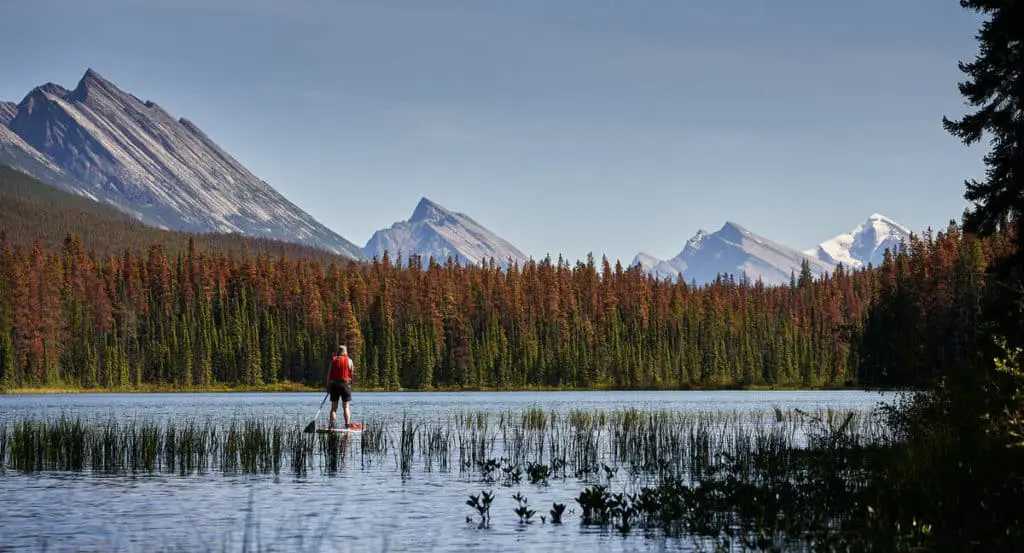
If you bring a non-motorized watercraft like a canoe, kayak or SUP, you must also undergo an inspection or complete the required self-certification permit.
This applies whenever you enter a new lake, river or stream in Banff.
You can do so either in person at one of the about 30 self-certification stations in the park or online at the website of Parks Canada.
Any inflatable boat or toy, including canoes, kayaks, rafts, stand-up paddleboards, and fishing gear (rods, wading boots, gloves, tackle and waders), are all subject to the requirement for a license.
Also included are life jackets, throw bags, water shoes, wetsuits, and water toys.
Motorized Watercraft
There are a few things that you need to keep in mind for boating in Banff National Park. As a motorized boat driver, you must have your boat inspected at the Lake Minnewanka inspection station before you hit the water.
You can find the station along the Minnewanka Loop Road, about 6 kilometers from the town of Banff. Here, you can get a Parks Canada AIS Prevention Inspection Permit for motorized watercraft upon inspection. Provincial AIS inspections are not accepted.
Fishing
If you plan to fish in Banff National Park, you must have a fishing license. You can purchase one online or at the park’s visitor centers. They are required for anyone over 16.
Want to know more about fishing in Banff? Read the Ultimate Guide to Fishing in Banff.
Diving
If you want to go scuba diving in Banff National Park, the only places this is permitted are Lake Minnewanka and Two Jack Lake.
All divers should be trained and certified by a certified organization. The supervision of a licensed diving instructor is required for trainees.
Water shoes, wetsuits, and any other recreational equipment that comes into contact with the water require self-certification.
Is There Swimming With Lifeguards in Banff?
Because most bodies of water are too chilly for swimming, most lakes in the park don’t have any lifeguards to keep people safe. However, Johnson Lake does have lifeguards in summer as it is one of the few lakes that are not glacially fed and, therefore, warm enough to allow for swimming.
Hot springs in the Rockies also have lifeguards on duty for your protection, like the Banff Hot Springs on Sulphur Mountain.
Are Water Activities in Banff Accessible By Public Transport?
Yes, some of them are. Roam Public Transit serves the area around the towns of Banff and Canmore.
Its routes take you, among others, to Lake Minnewanka, Two Jack Lake, Cascade Ponds, Banff Hot Springs, Lake Louise, and Moraine Lake.
For more information on routes and schedules, see the website of Roam Transit.
Banff Travel Guide and FAQ
Where is Banff National Park, Canada?
Banff National Park is in the southwest of the province of Alberta. It’s home to the towns of Banff and Lake Louise and borders the province of British Columbia in the west of Canada. You can easily access famous places like Lake Louise, Moraine Lake, Peyto Lake and the stunning Icefields Parkway from these locations.
Banff and Lake Louise are situated in the Rocky Mountains of Alberta, close to the boundary with British Columbia, as shown on the map of Banff National Park below.
Is Banff, Canada safe?
Generally speaking, yes. Like most areas, Banff has crime, but it’s still a safe travel place. But Banff has a lot of wildlife, including bears and cougars, so you should always carry bear spray and exercise caution when hiking in the mountains.
What is the best time to Travel to Banff, Canada?
The best time to travel to Banff, Canada, depends on your reason for visiting the park. If you’re going for the stunning nature the park’s famous for, you’d better visit from June to September. The best months to ski are from January through March.
WEATHER IN BANFF, CANADA: AVERAGE TEMPERATURE

The worst months to visit Banff National Park are November, April and May. It’s too chilly to go sightseeing in November, and there isn’t enough snow on the slopes yet. The iconic lakes in the park are still frozen in April and May, and it can still be quite cold.
How do I travel to Banff, Canada?
Want to fly to Banff? Calgary International Airport (Code: YYC) is the closest airport. It’s 130 kilometers (81 mi) to the east of Banff.
Several cities, including Toronto, Chicago, Seattle, and Dallas/Fort Worth, have direct flights into Calgary.
Pick up a rental vehicle at Calgary International Airport, or take a private transport service to your destination. The trip to the park takes about 1 hour and 40 minutes.
Viator has several good options. Click the link to check the options and latest rates.
Banff Car Rental
Want to rent a car during your stay in Banff National Park? Rent one at Calgary International Airport or in the city of Calgary. Yep, there are rental firms in Lake Louise and Banff, but as these are small towns, your rental options can be limited.
Avis is a reputable car rental company, which I’ve used many times. Book now with Avis
What do I pack for Banff, Canada?
The time of year will affect what you should bring with you on your trip to Banff, Canada. If you plan to spend your summer vacation in Banff National Park, you should be okay with light-colored, breathable clothing. Bring a few sweaters, too, as Banff’s summer evenings can be chilly. You’re in the mountains, after all.
When visiting in winter, bring a heavy jacket, such as a parka, and other winter clothing, such as warm pants, long underwear, and (fleece) sweaters. Don’t take it lightly because Banff’s wintertime lows can reach well below zero.
Banff Travel Planning Guide
Do I need a visa for Banff?
Most likely not. Citizens of the US, most European countries, Australia and New Zealand don’t need a visa to enter Canada. Not sure? Click the link to see whether you need a visa or not. The typical length of stay in Canada for people with visa-exempt passports is 90 days.
Do I need travel insurance for Banff?
You bet. Feel confident while traveling with a plan from Travel Insurance Master, one of the top names in travel insurance, for just USD 10 on average per day.
What’s the best way to book my Banff accommodation?
If you plan to book a hotel, hostel or bed & breakfast, Booking.com is your best bet. It has the most hotels listed and often offers the best rates.
Do I need to rent a car in Banf?
Absolutely. While Banff is one of the few national parks in North America with a sizeable public transport network, I strongly advise renting a car if you want to make the most of your visit.
Will my phone work in Banff?
It depends. In the towns of Banff and Lake Louise, you should have good to excellent reception. However, in more remote areas, the signal is spotty. In many places, there will be no signal at all.
What’s the best site to buy Banff flights?
If you’re looking for cheap flights to Banff, I recommend Skyscanner. No surprises with suddenly increased rates (for taxes, seats or luggage) upon checkout. What you see is what you get.

